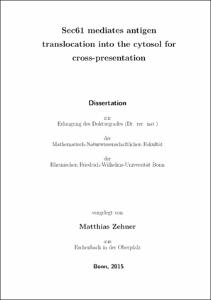Zehner, Matthias: Sec61 mediates antigen translocation into the cytosol for cross-presentation. - Bonn, 2016. - Dissertation, Rheinische Friedrich-Wilhelms-Universität Bonn.
Online-Ausgabe in bonndoc: https://nbn-resolving.org/urn:nbn:de:hbz:5n-42479
Online-Ausgabe in bonndoc: https://nbn-resolving.org/urn:nbn:de:hbz:5n-42479
@phdthesis{handle:20.500.11811/6700,
urn: https://nbn-resolving.org/urn:nbn:de:hbz:5n-42479,
author = {{Matthias Zehner}},
title = {Sec61 mediates antigen translocation into the cytosol for cross-presentation},
school = {Rheinische Friedrich-Wilhelms-Universität Bonn},
year = 2016,
month = jan,
note = {The mechanisms regulating non canonical protein transport across cellular membranes are poorly understood. Cross-presentation of exogenous antigens on MHC I by dendritic cells generally require antigen translocation from the endosomal compartment into the cytosol for proteasomal degradation. In our study we were able to show for the first time directly that protein translocation for cross-presentation is mediated by the protein transport channel sec61.
Antigens internalized by the mannose receptor (MR), a receptor that targets its ligands specifically towards cross-presentation, were translocated into the cytosol only in presence of a functionally sec61 channel protein. Protein export into the cytosol was specifically affected by knock down or inhibitory blocking of sec61. We were able to show by the establishment of a novel method, which allowed a flow-cytometrical analysis of individual endosomes, that sec61 is recruited to endosomal compartments where cross-presentation is mediated. In this study, we further demonstrated that not only the function of sec61 is important but the specific recruitment of ER associated sec61 proteins to the endosomal side action is essential for a working antigen transport mechanism. Therefore we intracellulary expressed antibodies against sec61 in combination with an ER retention sequence to specifically inhibit the recruitment of sec61 to endosomal compartments. This ER retention diminished the antigen export as well as cross-presentation of p97 to endosomal compartments for cross-presentation points out, that the antigen export for degradation is mediated by the specific recruitment of components of the ER-associated degradation machinery from the ER and well controlled by different mechanisms.},
url = {https://hdl.handle.net/20.500.11811/6700}
}
urn: https://nbn-resolving.org/urn:nbn:de:hbz:5n-42479,
author = {{Matthias Zehner}},
title = {Sec61 mediates antigen translocation into the cytosol for cross-presentation},
school = {Rheinische Friedrich-Wilhelms-Universität Bonn},
year = 2016,
month = jan,
note = {The mechanisms regulating non canonical protein transport across cellular membranes are poorly understood. Cross-presentation of exogenous antigens on MHC I by dendritic cells generally require antigen translocation from the endosomal compartment into the cytosol for proteasomal degradation. In our study we were able to show for the first time directly that protein translocation for cross-presentation is mediated by the protein transport channel sec61.
Antigens internalized by the mannose receptor (MR), a receptor that targets its ligands specifically towards cross-presentation, were translocated into the cytosol only in presence of a functionally sec61 channel protein. Protein export into the cytosol was specifically affected by knock down or inhibitory blocking of sec61. We were able to show by the establishment of a novel method, which allowed a flow-cytometrical analysis of individual endosomes, that sec61 is recruited to endosomal compartments where cross-presentation is mediated. In this study, we further demonstrated that not only the function of sec61 is important but the specific recruitment of ER associated sec61 proteins to the endosomal side action is essential for a working antigen transport mechanism. Therefore we intracellulary expressed antibodies against sec61 in combination with an ER retention sequence to specifically inhibit the recruitment of sec61 to endosomal compartments. This ER retention diminished the antigen export as well as cross-presentation of p97 to endosomal compartments for cross-presentation points out, that the antigen export for degradation is mediated by the specific recruitment of components of the ER-associated degradation machinery from the ER and well controlled by different mechanisms.},
url = {https://hdl.handle.net/20.500.11811/6700}
}






